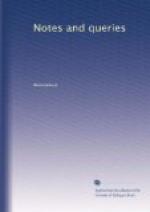This entry undoubtedly relates to the author of three very rare poetical tracts: 1. The Young Gallant’s Whirligigg, 1629; 2. The Innes of Court, 1634; 3. Great Brittain’s Beauties, 1638. In the dedication to Sir Julius Caesar, prefixed to the first-named work, the writer speaks of having “once belonged to the Innes of Court,” and says he was “no usuall poetizer, but, to barre idlenesse, imployed that little talent the Muses conferr’d upon him in this little tract.” Sir Egerton Brydges supposed the copy of The Young Gallant’s Whirligigg preserved in the library of Sion College to be unique; but this is not the case, as the writer knows of two others,—one at Staunton Hall, and another at Tixall Priory in Staffordshire. It has been reprinted by Mr. {118} Halliwell at the end of a volume containing The Marriage of Wit and Wisdom, published by the Shakspeare Society. In his prefatory remarks that gentleman says,
“Besides his printed
works, Lenton wrote the Poetical History
of Queene Hester, with
the translation of the 83rd Psalm,
reflecting upon the present
times. MS. dated 1649.”
This date must be incorrect, if our entry in the Staunton obituary relates to the same person; and there is every reason to suppose that it does. The autograph MS. of Lenton occurred in Heber’s sale (Part xi. No. 724.), and is thus described:
Hadassiah, or the History
of Queen Hester, sung in a sacred
and serious poeme, and divided
into ten chapters, by F. Lenton,
the Queen’s Majesties
Poet, 1638.
This is undoubtedly the correct date, as it is in the handwriting of the author. Query. What is the meaning of Lenton’s title, “the Queen’s Majesties Poet”?
Edward F. Rimbault.
* * * * *
Minor Notes.
Lilburn or Prynne?—I am anxious to suggest in “Notes and Queries” whether a character in the Second Canto of Part iii. of Hudibras (line 421), beginning,
“To match this saint, there was
another,
As busy and perverse a brother,
An haberdasher of small wares,
In politics and state affairs,”
Has not been wrongly given by Dr. Grey to Lilburn, and whether Prynne is not rather the person described. Dr. Grey admits in his note that the application of the passage to Lilburn involves an anachronism, Lilburn having died in 1657, and this passage being a description of one among
“The quacks of government who sate”
to consult for the Restoration, when they saw ruin impending.
CH.




